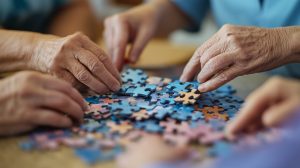When it comes to memories, “where” has a special meaning. Where did I put my keys? Where did I eat last night? Where did I meet this friend for the first time? Remembering places is necessary for everyday life, but spatial memory—which keeps track of “where”—is one of the first cognitive abilities to decline with age. And deficits in younger years can be a sign of dementia. Now, researchers at Stanford Medicine and their colleagues are investigating what goes wrong in older brains when spatial memory declines and whether these changes can be prevented.
Decline in Spatial Memory May Not be an Inevitable Part of Advanced Age
In a new study comparing young, middle-aged, and old mice, researchers found that activity in the medial entorhinal cortex—sometimes compared to the brain’s global positioning system—is less stable and less attuned to the environment in older animals. Those with the most impaired activity in this brain region were the most confused on a spatial memory test.
“You can think of the medial entorhinal cortex as a place where all the components you need to create a map of space are present,” said Lisa Giocomo, PhD, professor of neurobiology and senior author of the study, which was published in Nature Communications. Prior to this study, there had been very little work on what actually happens to this spatial mapping system during healthy aging.
Although older mice were, on average, significantly worse than their younger counterparts at navigating their environment, there were large differences between them—a sign that the decline in spatial memory may not be an inevitable part of advanced age.
Mental Maps
The medial entorhinal cortex is an essential part of the brain’s navigation system. It contains a variety of cells that track different information, including the animal’s speed and head orientation, as well as the dimensions and boundaries of a space. For the new study, the researchers focused on so-called grid cells, which create a map of the environment, almost like a longitude and latitude system.
They studied mice in three age categories: young mice around 3 months old, middle-aged mice around 13 months old, and old mice around 22 months old. These age groups roughly correspond to 20-year-olds, 50-year-olds, and 75- to 90-year-olds in humans. The researchers recorded the brain activity of slightly thirsty mice as they searched for hidden rewards—a sip of water—on virtual reality tracks. They ran on a stationary ball surrounded by screens displaying the virtual environment, similar to a mouse-sized treadmill in a mouse-sized Imax theater.
Each mouse ran the tracks hundreds of times over six days. (Mice are naturally enthusiastic runners, the researchers noted.) With sufficient repetition, mice of all ages were able to learn the location of a hidden reward on a particular track. By the sixth day, they only stopped to lick the reward locations. Accordingly, the grid cells in their medial entorhinal cortex developed different firing patterns for each track, as if they were creating individual mental maps.
Switching Tracks
However, when given a more difficult task in which the mice had to randomly switch between two different tracks they had already learned, each with a different reward location, the older mice were overwhelmed—they seemed unable to determine which track they were on. “In this case, the task was more like remembering where you parked your car in two different parking lots or where your favorite café is located in two different cities,” Giocomo said.
Unsure of where they were, the old mice tended to sprint the rest of the way without stopping to look for rewards. A few chose a different tactic and tried to lick everywhere. Their grid cells reflected their confusion. Although they had developed different firing patterns for each track, their grid cells fired irregularly when the tracks were switched.
“Their spatial memory and rapid discrimination between these two environments were really impaired,” said Charlotte Herber, PhD, MD-PhD student and lead author of the study. The results appear to be consistent with human behavior. “Older people can often find their way around familiar spaces, such as their home or the neighborhood where they have always lived, but they find it really difficult to find their way around a new place, even with experience,” Giocomo said.
In contrast, both young and middle-aged mice understood the task by day six, and their grid cell activity quickly adapted to the respective track they were on. “Over the course of days one to six, they develop increasingly stable spatial firing patterns that are specific to context A and specific to context B. According to Heber, the old mice fail to develop these discrete spatial maps. The middle-aged mice showed slightly weaker patterns in their brain activity, but their performance was very similar to that of the young mice. The researchers believe that this cognitive ability remains intact at least until the age of about 13 months in mice, or perhaps 50 to 60 years in humans.
Super-Ager
While the young and middle-aged mice showed consistent performance within their age groups, the oldest mice showed greater differences in spatial memory. Male mice generally performed better than females, although researchers do not yet know why. One older male mouse stood out in particular: it aced the test and remembered the hidden reward locations on the alternating tracks just as well, if not better, than the young and middle-aged mice.
In fact, the super-ager mouse confirmed the link between grid cell activity and spatial memory. Its grid cells were as unusually lively as its behavior, firing clearly and precisely in every environment. “The variability in the older group allowed us to establish these correlative relationships between neural function and behavior,” Herber said.
The super-ager mouse also encouraged researchers to look for genetic differences that might underlie variability in the aging process. They sequenced the RNA of young and old mice and found 61 genes that were more highly expressed in mice with unstable grid cell activity. These genes could be involved in either promoting or compensating for the decline in spatial memory, the researchers said.
The Haplin4 gene, for example, contributes to the network of proteins that surround neurons, known as the perineuronal net. This could help strengthen the stability of grid cells and protect the spatial memory of aging mice. Just like mice, humans also show varying degrees of aging. Part of the goal of this work is to understand some of these differences—why some people are more resistant to aging and others are more susceptible.







